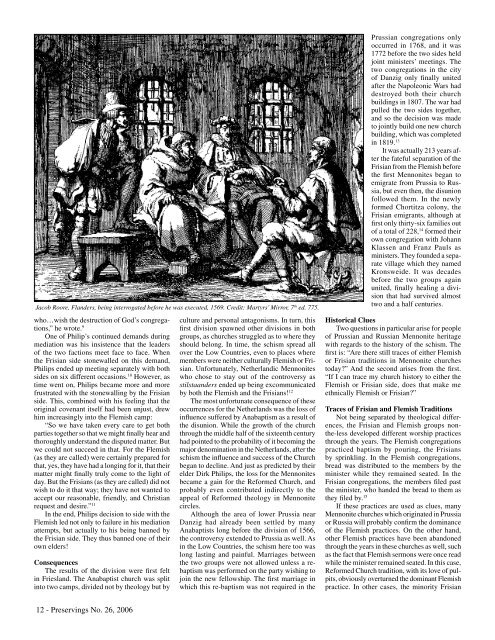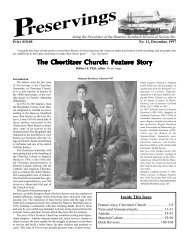Preservings $20 Issue No. 26, 2006 - Home at Plett Foundation
Preservings $20 Issue No. 26, 2006 - Home at Plett Foundation
Preservings $20 Issue No. 26, 2006 - Home at Plett Foundation
You also want an ePaper? Increase the reach of your titles
YUMPU automatically turns print PDFs into web optimized ePapers that Google loves.
Jacob Roore, Flanders, being interrog<strong>at</strong>ed before he was executed, 1569. Credit: Martyrs’ Mirror, 7 th ed. 775.<br />
who…wish the destruction of God’s congreg<strong>at</strong>ions,”<br />
he wrote. 9<br />
One of Philip’s continued demands during<br />
medi<strong>at</strong>ion was his insistence th<strong>at</strong> the leaders<br />
of the two factions meet face to face. When<br />
the Frisian side stonewalled on this demand,<br />
Philips ended up meeting separ<strong>at</strong>ely with both<br />
sides on six different occasions. 10 However, as<br />
time went on, Philips became more and more<br />
frustr<strong>at</strong>ed with the stonewalling by the Frisian<br />
side. This, combined with his feeling th<strong>at</strong> the<br />
original covenant itself had been unjust, drew<br />
him increasingly into the Flemish camp:<br />
“So we have taken every care to get both<br />
parties together so th<strong>at</strong> we might finally hear and<br />
thoroughly understand the disputed m<strong>at</strong>ter. But<br />
we could not succeed in th<strong>at</strong>. For the Flemish<br />
(as they are called) were certainly prepared for<br />
th<strong>at</strong>, yes, they have had a longing for it, th<strong>at</strong> their<br />
m<strong>at</strong>ter might finally truly come to the light of<br />
day. But the Frisians (as they are called) did not<br />
wish to do it th<strong>at</strong> way; they have not wanted to<br />
accept our reasonable, friendly, and Christian<br />
request and desire.” 11<br />
In the end, Philips decision to side with the<br />
Flemish led not only to failure in his medi<strong>at</strong>ion<br />
<strong>at</strong>tempts, but actually to his being banned by<br />
the Frisian side. They thus banned one of their<br />
own elders!<br />
Consequences<br />
The results of the division were first felt<br />
in Friesland. The Anabaptist church was split<br />
into two camps, divided not by theology but by<br />
culture and personal antagonisms. In turn, this<br />
first division spawned other divisions in both<br />
groups, as churches struggled as to where they<br />
should belong. In time, the schism spread all<br />
over the Low Countries, even to places where<br />
members were neither culturally Flemish or Frisian.<br />
Unfortun<strong>at</strong>ely, Netherlandic Mennonites<br />
who chose to stay out of the controversy as<br />
stilstaanders ended up being excommunic<strong>at</strong>ed<br />
by both the Flemish and the Frisians! 12<br />
The most unfortun<strong>at</strong>e consequence of these<br />
occurrences for the Netherlands was the loss of<br />
influence suffered by Anabaptism as a result of<br />
the disunion. While the growth of the church<br />
through the middle half of the sixteenth century<br />
had pointed to the probability of it becoming the<br />
major denomin<strong>at</strong>ion in the Netherlands, after the<br />
schism the influence and success of the Church<br />
began to decline. And just as predicted by their<br />
elder Dirk Philips, the loss for the Mennonites<br />
became a gain for the Reformed Church, and<br />
probably even contributed indirectly to the<br />
appeal of Reformed theology in Mennonite<br />
circles.<br />
Although the area of lower Prussia near<br />
Danzig had already been settled by many<br />
Anabaptists long before the division of 1566,<br />
the controversy extended to Prussia as well. As<br />
in the Low Countries, the schism here too was<br />
long lasting and painful. Marriages between<br />
the two groups were not allowed unless a rebaptism<br />
was performed on the party wishing to<br />
join the new fellowship. The first marriage in<br />
which this re-baptism was not required in the<br />
Prussian congreg<strong>at</strong>ions only<br />
occurred in 1768, and it was<br />
1772 before the two sides held<br />
joint ministers’ meetings. The<br />
two congreg<strong>at</strong>ions in the city<br />
of Danzig only finally united<br />
after the Napoleonic Wars had<br />
destroyed both their church<br />
buildings in 1807. The war had<br />
pulled the two sides together,<br />
and so the decision was made<br />
to jointly build one new church<br />
building, which was completed<br />
in 1819. 13<br />
It was actually 213 years after<br />
the f<strong>at</strong>eful separ<strong>at</strong>ion of the<br />
Frisian from the Flemish before<br />
the first Mennonites began to<br />
emigr<strong>at</strong>e from Prussia to Russia,<br />
but even then, the disunion<br />
followed them. In the newly<br />
formed Chortitza colony, the<br />
Frisian emigrants, although <strong>at</strong><br />
first only thirty-six families out<br />
of a total of 228, 14 formed their<br />
own congreg<strong>at</strong>ion with Johann<br />
Klassen and Franz Pauls as<br />
ministers. They founded a separ<strong>at</strong>e<br />
village which they named<br />
Kronsweide. It was decades<br />
before the two groups again<br />
united, finally healing a division<br />
th<strong>at</strong> had survived almost<br />
two and a half centuries.<br />
Historical Clues<br />
Two questions in particular arise for people<br />
of Prussian and Russian Mennonite heritage<br />
with regards to the history of the schism. The<br />
first is: “Are there still traces of either Flemish<br />
or Frisian traditions in Mennonite churches<br />
today?” And the second arises from the first.<br />
“If I can trace my church history to either the<br />
Flemish or Frisian side, does th<strong>at</strong> make me<br />
ethnically Flemish or Frisian?”<br />
Traces of Frisian and Flemish Traditions<br />
<strong>No</strong>t being separ<strong>at</strong>ed by theological differences,<br />
the Frisian and Flemish groups nonthe-less<br />
developed different worship practices<br />
through the years. The Flemish congreg<strong>at</strong>ions<br />
practiced baptism by pouring, the Frisians<br />
by sprinkling. In the Flemish congreg<strong>at</strong>ions,<br />
bread was distributed to the members by the<br />
minister while they remained se<strong>at</strong>ed. In the<br />
Frisian congreg<strong>at</strong>ions, the members filed past<br />
the minister, who handed the bread to them as<br />
they filed by. 15<br />
If these practices are used as clues, many<br />
Mennonite churches which origin<strong>at</strong>ed in Prussia<br />
or Russia will probably confirm the dominance<br />
of the Flemish practices. On the other hand,<br />
other Flemish practices have been abandoned<br />
through the years in these churches as well, such<br />
as the fact th<strong>at</strong> Flemish sermons were once read<br />
while the minister remained se<strong>at</strong>ed. In this case,<br />
Reformed Church tradition, with its love of pulpits,<br />
obviously overturned the dominant Flemish<br />
practice. In other cases, the minority Frisian<br />
12 - <strong>Preservings</strong> <strong>No</strong>. <strong>26</strong>, <strong>2006</strong>
















